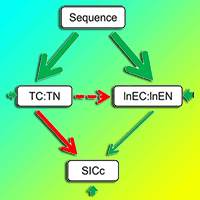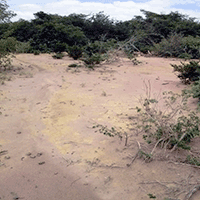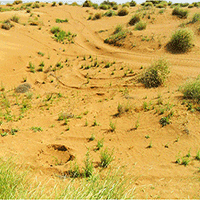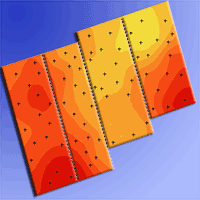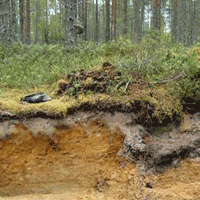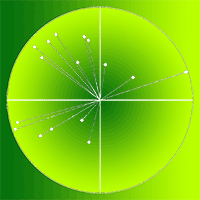Fast-growing Populus species are becoming frequently used at afforestation of arable land globally and hybrid aspen is promising for short rotation forestry in the northern hemisphere. Knowledge about growth performance of the second-generation plantations, i.e., consisting of root sucker generated shoots after clearcutting of the original stand, is increasing, but less information is available on the effects on soil properties, especially with varying management. We followed the soil effects of three different management regimes, including 4-, 8- and 16-year rotations with thinning measures in the two longer rotations, in root sucker generated hybrid aspen on former agricultural land. The study was performed in a randomized block design and changes in soil variables were estimated by repeated sampling, i.e., at root sucker initiation and after eight years. Concentrations and pools of soil organic carbon (SOC) and soil nutrients, pH and bulk density were analysed in the 0-15 and 15-30 cm mineral soil. Common for all management regimes were unchanged SOC and nutrient pools; pH and bulk density were also unaffected during the study period. Afforestation effects on the vertical distribution of nutrients, i.e., redistribution of NH4-N, K and Mg from deeper to shallower soil by plant uptake and release through litter decomposition, were observed in all management regimes. A different effect was noted for NO3-N where a declining trend was observed. This could indicate a leakage of the ion, but NO3-N distributions in soils are variable which makes interpretations difficult. The results suggest that different management strategies have small initial effects on mineral soil characteristics. However, soil changes need to be followed for an extended period to get more information on the long-term impact of afforestation and management of root sucker generated stands.
Keywords
, , , , , ,
Citation
Rytter R-M, Rytter L (2018). Effects on soil characteristics by different management regimes with root sucker generated hybrid aspen (Populus tremula L. × P. tremuloides Michx.) on abandoned agricultural land. iForest 11: 619-627. - doi: 10.3832/ifor2853-011
Academic Editor
Werther Guidi Nissim
Paper history
Received: May 17, 2018
Accepted: Aug 11, 2018
First online: Oct 04, 2018
Publication Date: Oct 31, 2018
Publication Time: 1.80 months
© SISEF - The Italian Society of Silviculture and Forest Ecology 2018
Open Access
This article is distributed under the terms of the Creative Commons Attribution-Non Commercial 4.0 International (https://creativecommons.org/licenses/by-nc/4.0/), which permits unrestricted use, distribution, and reproduction in any medium, provided you give appropriate credit to the original author(s) and the source, provide a link to the Creative Commons license, and indicate if changes were made.

Breakdown by View Type
(Waiting for server response...)
Article Usage
Total Article Views: 47509
(from publication date up to now)
Breakdown by View Type
HTML Page Views: 40709
Abstract Page Views: 3319
PDF Downloads: 2651
Citation/Reference Downloads: 9
XML Downloads: 821
Web Metrics
Days since publication: 2622
Overall contacts: 47509
Avg. contacts per week: 126.84
Article Citations
Article citations are based on data periodically collected from the Clarivate Web of Science web site
(last update: Mar 2025)
Total number of cites (since 2018): 5
Average cites per year: 0.63
Publication Metrics
by Dimensions ©
Articles citing this article
List of the papers citing this article based on CrossRef Cited-by.
(1)
Atterberg A (1905)Die rationale Klassifikation der Sande und Kiese. [The rational classification of sand and gravel]. Chemiker-Zeitung 29: 195-198.
Gscholar
(2)
AgroEcoLab@UMD (2018)Mehlich 3 extraction protocol. University of Maryland, College Park, MD, USA, Web Site.
Online |
Gscholar
(3)
Alban DH (1982)Effects of nutrient accumulation by aspen, spruce, and pine on soil properties. Soil Science Society of America Journal 46: 853-861.
CrossRef |
Gscholar
(4)
Anonymous (2012)Improving lives with poplars and willows. In: “Synthesis of Country Progress Reports”. International Poplar Commission, 24th session, Dehradun (India) 30 Oct-2 Nov 2012. Working Paper IPC/12E, FAO, Rome, Italy, pp. 93.
Gscholar
(5)
Arevalo CBM, Bhatti JS, Chang SX, Sidders D (2011)Land use change effects on ecosystem carbon balance: from agricultural to hybrid poplar plantation. Agriculture, Ecosystems and Environment 141: 342-349.
CrossRef |
Gscholar
(6)
Binkley D (1995)The influence of tree species on forest soils: processes and patterns. In: Proceedings of the “Trees and Soil Workshop” (Mead DJ, Cornforth IS eds). Lincoln University, Agronomy Society of New Zealand, Special Publication no. 10, Lincoln University Press, Canterbury, New Zealand, pp. 1-33.
Gscholar
(7)
Bronick CJ, Lal R (2005)Soil structure and management, a review. Geoderma 124: 3-22.
CrossRef |
Gscholar
(8)
Deng Q, McMahon DE, Xiang Y, Yu C-L, Jackson RB, Hui D (2017)A global meta-analysis of soil phosphorus dynamics after afforestation. New Phytologist 213: 181-192.
CrossRef |
Gscholar
(9)
Eriksson J, Andersson A, Andersson R (1999)Texture of agricultural topsoils in Sweden. Report no. 4955, Naturvårdsverket, Stockholm, Sweden, pp. 48. [In Swedish with English summary]
Gscholar
(10)
Eriksson J, Mattsson L, Söderström M (2010)Current status of Swedish arable soils and cereal crops. Data from the period 2001-2007. Naturvårdsverket, Stockholm, Sweden, pp. 129. [In Swedish with English summary]
Gscholar
(11)
FAO (2006)Guidelines for soil description. Soil Resources Development and Conservation Service, Land and Water Development Division, FAO, Rome, Italy, pp. 98.
Gscholar
(12)
Grigal DF, Berguson WE (1998)Soil carbon changes associated with short-rotation systems. Biomass and Bioenergy 14: 371-377.
CrossRef |
Gscholar
(13)
Hansen EA (1993)Soil carbon sequestration beneath hybrid poplar plantations in the North Central United States. Biomass and Bioenergy 5: 431-436.
CrossRef |
Gscholar
(14)
Hedenus F, Azar C (2009)Bioenergy plantations or long-term carbon sinks? A model based analysis. Biomass and Bioenergy 33: 1693-1702.
CrossRef |
Gscholar
(15)
Hepler PK (2005)Calcium: a central regulator of plant growth and development. The Plant Cell 17: 2142-2155.
CrossRef |
Gscholar
(16)
Jandl R, Lindner M, Vesterdal L, Bauwens B, Baritz R, Hagedorn F, Johnson DW, Minkkinen K, Byrne KA (2007)How strongly can forest management influence soil carbon sequestration? Geoderma 137: 253-268.
CrossRef |
Gscholar
(17)
Jobbágy EG, Jackson RB (2001)The distribution of soil nutrients with depth: global patterns and the imprint of plants. Biogeochemistry 53: 51-77.
CrossRef |
Gscholar
(18)
Johansson T (2013)Biomass production of hybrid aspen growing on former farm land in Sweden. Journal of Forestry Research 24: 237-246.
CrossRef |
Gscholar
(19)
Johnson DW, Curtis PS (2001)Effects of forest management on soil C and N storage: meta analysis. Forest Ecology and Management 140: 227-238.
CrossRef |
Gscholar
(20)
Jug A, Makeschin F, Rehfuess KE, Hofmann-Schielle C (1999)Short-rotation plantations of balsam poplars, aspen and willows on former arable land in the Federal Republic of Germany. III. Soil ecological effects. Forest Ecology and Management 121: 85-99.
CrossRef |
Gscholar
(21)
Jurgensen M, Tarpey R, Pickens J, Kolka R, Palik B (2012)Long-term effect of silvicultural thinnings on soil carbon and nitrogen pools. Soil Science Society of America Journal 76: 1418-1425.
CrossRef |
Gscholar
(22)
Koerner W, Dupouey JL, Dambrine E, Benoît M (1997)Influence of past land use on the vegetation and soils of present day forest in the Vosges mountains, France. Journal of Ecology 85: 351-358.
CrossRef |
Gscholar
(23)
Lal R (2008)Carbon sequestration. Philosophical Transactions of the Royal Society B 363: 815-830.
CrossRef |
Gscholar
(24)
Liesebach M, Von Wuehlisch G, Muhs H-J (1999)Aspen for short-rotation coppice plantations on agricultural sites in Germany: effects of spacing and rotation time on growth and biomass production of aspen progenies. Forest Ecology and Management 121: 25-39.
CrossRef |
Gscholar
(25)
Lutter R, Tullus A, Kanal A, Tullus T, Tullus H (2016a)The impact of former land-use type to above- and below-ground C and N pools in short-rotation hybrid aspen (
Populus tremula L. ×
P. tremuloides Michx.) plantations in hemiboreal conditions. Forest Ecology and Management 378: 79-90.
CrossRef |
Gscholar
(26)
Lutter R, Tullus A, Kanal A, Tullus T, Tullus H (2016b)The impact of short-rotation hybrid aspen (
Populus tremula L. ×
P. tremuloides Michx.) plantations on nutritional status of former arable soils. Forest Ecology and Management 362: 184-193.
CrossRef |
Gscholar
(27)
McCarthy R, Rytter L (2015)Productivity and thinning effects in hybrid aspen root sucker stands. Forest Ecology and Management 354: 215-223.
CrossRef |
Gscholar
(28)
McNabb DH, Cromack K, Fredriksen RL (1986)Variability of nitrogen and carbon in surface soils of six forest types in the Oregon Cascades. Soil Science Society of America Journal 50: 1037-1041.
CrossRef |
Gscholar
(29)
Nave LE, Vance ED, Swanston CW, Curtis PS (2010)Harvest impacts on soil carbon storage in temperate forests. Forest Ecology and Management 259: 857-866.
CrossRef |
Gscholar
(30)
Nilsen P, Strand T (2008)Thinning intensity effects on carbon and nitrogen stores and fluxes in a Norway spruce (
Picea abies (L.) Karst.) stand after 33 years. Forest Ecology and Management 256: 201-208.
CrossRef |
Gscholar
(31)
Olesen PO (1971)The water displacement method - A fast and accurate method of determining the green volume of wood samples. Arboretet Hørsholm, Akademisk Forlag, København, Denmark. Forest Tree Improvement 3: 3-23.
Gscholar
(32)
R Core Team (2017)R: a language and environment for statistical computing. R Foundation for Statistical Computing, Vienna, Austria.
Online |
Gscholar
(33)
Ritter E, Vesterdal L, Gundersen P (2003)Changes in soil properties at afforestation of former intensively managed soils with oak and Norway spruce. Plant and Soil 249: 319-330.
CrossRef |
Gscholar
(34)
Rosenberg O, Jacobson S (2004)Effects of repeated slash removal in thinned stands on soil chemistry and understorey vegetation. Silva Fennica 38 (2): 133-142.
CrossRef |
Gscholar
(35)
Rosenqvist L, Kleja DB, Johansson M-B (2010)Concentrations and fluxes of dissolved organic carbon and nitrogen in a
Picea abies chronosequence on former arable land in Sweden. Forest Ecology and Management 259: 275-285.
CrossRef |
Gscholar
(36)
Rytter L (2002)Nutrient content in stems of hybrid aspen as affected by tree age and tree size, and nutrient removal with harvest. Biomass and Bioenergy 23: 13-25.
CrossRef |
Gscholar
(37)
Rytter L, Johansson T, Karačić A, Weih M (2011)Orienterande studie om ett svenskt forskningsprogram för poppel. [Investigation for a Swedish research program on the genus
Populus]. Skogforsk, Arbetsrapport no. 733, Uppsala, Sweden, pp. 148. [In Swedish with English summary]
Gscholar
(38)
Rytter L, Johansson K, Karlsson B, Stener L-G (2013)Tree species, genetics and regeneration for bioenergy feedstock in northern Europe. In: “Forest BioEnergy Production” (Kellomäki S, Kilpeläinen A, Alam A eds). Springer Science+ Business Media, New York, USA, pp. 7-37.
CrossRef |
Gscholar
(39)
Rytter L, Rytter R-M (2017)Productivity and sustainability of hybrid aspen (
Populus tremula L. ×
P. tremuloides Michx.) root sucker stands with varying management strategies. Forest Ecology and Management 401: 223-232.
CrossRef |
Gscholar
(40)
Rytter R-M (2012a)The potential of willow and poplar plantations as carbon sinks in Sweden. Biomass and Bioenergy 36: 86-95.
CrossRef |
Gscholar
(41)
Rytter R-M (2012b)Stone and gravel content of arable soils influence estimates of C and N stocks. Catena 95: 153-159.
CrossRef |
Gscholar
(42)
Rytter R-M (2016)Afforestation of former agricultural land with Salicaceae species - initial effects on soil organic carbon, mineral nutrients, C:N and pH. Forest Ecology and Management 363: 21-30.
CrossRef |
Gscholar
(43)
SMHI (2018a)Klimatindikator - vegetationsperiodens längd [Climate indicator - Length of vegetation]. Swedish Meteorological and Hydrological Institute, Norrköping, Sweden, Web site. [in Swedish]
Online |
Gscholar
(44)
SMHI (2018b)Dataserier med normalvärden för perioden 1961-1990 [Data series with normal values for the period 1961-1990]. Swedish Meteorological and Hydrological Institute, Norrköping, Sweden, Web site. [in Swedish]
Online |
Gscholar
(45)
Telenius BF (1999)Stand growth of deciduous pioneer tree species on fertile agricultural land in southern Sweden. Biomass and Bioenergy 16: 13-23.
CrossRef |
Gscholar
(46)
Tullus A, Rytter L, Tullus T, Weih M, Tullus H (2012)Short-rotation forestry with hybrid aspen (
Populus tremula L. ×
P. tremuloides Michx.) in Northern Europe. Scandinavian Journal of Forest Research 27: 10-29.
CrossRef |
Gscholar
(47)
White RE (2006)Principles and practice of soil science - The soil as a natural resource (4th edn). Wiley-Blackwell Publishing, Oxford, UK, pp. 376.
Gscholar


